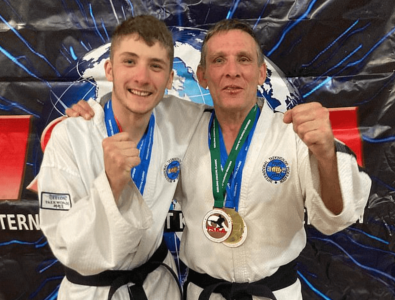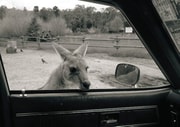57-year-old man reveals what it's like to ‘die’ and come back to life
- Replies 5
Phill Zdybel, a 57-year-old Taekwondo instructor, experienced something many people fear and wonder about – what it's like to die.
During a basketball game last November in Geelong, he suffered a sudden cardiac arrest, and his heart stopped beating for almost half an hour. Zdybel had no warning signs before the event, caused by a coronary artery aneurysm, leaving him clinically dead for 28 minutes.
Thankfully, help was nearby. Zdybel's son Joshua quickly called paramedics while an off-duty nurse, who happened to be at the game, rushed over to perform CPR. Fellow attendees found a defibrillator at the centre and used it in a desperate attempt to revive Zdybel.

Despite the quick response, Zdybel says that while lying on the ground, he felt as though he was observing what was happening from outside his body. It's a shared experience reported by many who have survived cardiac arrests.
As he watched the frantic efforts to save his life, Zdybel knew he was on the brink of death.
The incident left him with a new appreciation for life and a desire to spread awareness about the importance of knowing CPR and the location of nearby defibrillators. Zdybel's experience is a powerful reminder of how quickly life can change and how important it is to be prepared for the unexpected.
In an interview with the Geelong Advertiser, Zdybel revealed that during the incident, he felt as if he was a bit out of his body. However, his strong will to live kicked in, and he was sure he would survive.
'I was not going anywhere,' he added. Zdybel believes that collapsing in front of so many people who were able to help and call for assistance was nothing short of a miracle.
Had it happened elsewhere, he said, there is a good chance that 'no one would have found him', and he would be dead.
'I'm a miracle man,' he said.
After the collapse, Zdybel was rushed to the hospital, where he woke up several days later on life support and was told he had been clinically dead for 28 minutes. He had a stent fitted in his heart and was discharged from the hospital a week later.
Initially, Zdybel considered giving up martial arts after his health scare. However, six months later, he's back at it and even participated in a competition recently. While he's mostly recovered, he admitted that he tires more quickly than he used to.
Facing his mortality has given Zdybel a different perspective on life. He thinks people should worry less about the little things and not let anyone tell them they can't do anything.
He's also urging people to learn potentially life-saving CPR and advocating for defibrillators to be widely available nationwide.

Phill Zdybel's story shows strength, resilience, and a renewed appreciation for life. His experience of 'dying' and returning has given him a new outlook on the world and the things that truly matter.
It's easy to get bogged down by the little things, but his story reminds us that life is precious and we should cherish every moment.
His advocacy for learning CPR and having readily available defibrillators is crucial to ensuring that more lives can be saved.
CPR (cardiopulmonary resuscitation) is a first aid technique that can save a life if someone is not breathing correctly or their heart has stopped. It involves pressing on the chest and giving breaths to help keep the brain and vital organs alive.
You should start CPR if a person:
Remember, starting CPR as soon as possible can make a huge difference in saving someone's life — you could be the difference between life and death for someone in need.
Credit: Royal Lifesaving Australia.
An AED (automated external defibrillator), also known as a 'defib', is a small electronic device that can be used during a medical emergency to help someone suffering from sudden cardiac arrest.
When a person's heart is in a dangerous rhythm, an AED can detect and analyse their heart activity. If necessary, the AED will deliver a sharp electric shock, known as defibrillation, to the heart through the chest. This can help restore a normal rhythm to the heart.
Anyone can use an AED and you don't need medical training. The device will have instructions.
To learn how to use an AED, you can watch a simple training video like the one provided by Response for Life. In this video, an accredited instructor will explain step-by-step how to use a defibrillator.
Credit: Victor Chang Cardiac Research Institute.
As we go about our daily lives, it's easy to forget that at any moment, everything can change. Zdybel's story is a reminder to live each day to the fullest and never take a moment for granted.
So, what do you think? Have you ever been faced with your own mortality? Have you taken steps to prepare for an emergency? Share your thoughts in the comments below.
During a basketball game last November in Geelong, he suffered a sudden cardiac arrest, and his heart stopped beating for almost half an hour. Zdybel had no warning signs before the event, caused by a coronary artery aneurysm, leaving him clinically dead for 28 minutes.
Thankfully, help was nearby. Zdybel's son Joshua quickly called paramedics while an off-duty nurse, who happened to be at the game, rushed over to perform CPR. Fellow attendees found a defibrillator at the centre and used it in a desperate attempt to revive Zdybel.

Phill Zdybel (right), pictured with his son Joshua, collapsed due to a cardiac arrest during a basketball game. Credit: Facebook.
Despite the quick response, Zdybel says that while lying on the ground, he felt as though he was observing what was happening from outside his body. It's a shared experience reported by many who have survived cardiac arrests.
As he watched the frantic efforts to save his life, Zdybel knew he was on the brink of death.
The incident left him with a new appreciation for life and a desire to spread awareness about the importance of knowing CPR and the location of nearby defibrillators. Zdybel's experience is a powerful reminder of how quickly life can change and how important it is to be prepared for the unexpected.
In an interview with the Geelong Advertiser, Zdybel revealed that during the incident, he felt as if he was a bit out of his body. However, his strong will to live kicked in, and he was sure he would survive.
'I was not going anywhere,' he added. Zdybel believes that collapsing in front of so many people who were able to help and call for assistance was nothing short of a miracle.
Had it happened elsewhere, he said, there is a good chance that 'no one would have found him', and he would be dead.
'I'm a miracle man,' he said.
After the collapse, Zdybel was rushed to the hospital, where he woke up several days later on life support and was told he had been clinically dead for 28 minutes. He had a stent fitted in his heart and was discharged from the hospital a week later.
Initially, Zdybel considered giving up martial arts after his health scare. However, six months later, he's back at it and even participated in a competition recently. While he's mostly recovered, he admitted that he tires more quickly than he used to.
Facing his mortality has given Zdybel a different perspective on life. He thinks people should worry less about the little things and not let anyone tell them they can't do anything.
He's also urging people to learn potentially life-saving CPR and advocating for defibrillators to be widely available nationwide.
Key Takeaways
- Phill Zdybel, a Taekwondo instructor, suffered a cardiac arrest during a basketball game that left him clinically dead for 28 minutes due to a coronary artery aneurysm.
- After collapsing, his son Joshua called paramedics, and an off-duty nurse performed CPR while fellow attendees found a defibrillator to revive him.
- While he was 'dead', he felt he was observing what was happening from outside his body.
- Since then, Zdybel has returned to martial arts, urging people to learn CPR and advocating for defibrillators to be more widely available.
Phill Zdybel's story shows strength, resilience, and a renewed appreciation for life. His experience of 'dying' and returning has given him a new outlook on the world and the things that truly matter.
It's easy to get bogged down by the little things, but his story reminds us that life is precious and we should cherish every moment.
His advocacy for learning CPR and having readily available defibrillators is crucial to ensuring that more lives can be saved.
CPR (cardiopulmonary resuscitation) is a first aid technique that can save a life if someone is not breathing correctly or their heart has stopped. It involves pressing on the chest and giving breaths to help keep the brain and vital organs alive.
You should start CPR if a person:
- is unconscious,
- is not responding to you,
- is not breathing, or is breathing abnormally.
Remember, starting CPR as soon as possible can make a huge difference in saving someone's life — you could be the difference between life and death for someone in need.
Credit: Royal Lifesaving Australia.
An AED (automated external defibrillator), also known as a 'defib', is a small electronic device that can be used during a medical emergency to help someone suffering from sudden cardiac arrest.
When a person's heart is in a dangerous rhythm, an AED can detect and analyse their heart activity. If necessary, the AED will deliver a sharp electric shock, known as defibrillation, to the heart through the chest. This can help restore a normal rhythm to the heart.
Anyone can use an AED and you don't need medical training. The device will have instructions.
To learn how to use an AED, you can watch a simple training video like the one provided by Response for Life. In this video, an accredited instructor will explain step-by-step how to use a defibrillator.
Credit: Victor Chang Cardiac Research Institute.
As we go about our daily lives, it's easy to forget that at any moment, everything can change. Zdybel's story is a reminder to live each day to the fullest and never take a moment for granted.
So, what do you think? Have you ever been faced with your own mortality? Have you taken steps to prepare for an emergency? Share your thoughts in the comments below.







